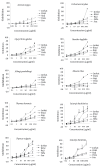An Investigation of the Growth Inhibitory Capacity of Several Medicinal Plants From Iran on Tumor Cell Lines
- PMID: 26634114
- PMCID: PMC4667231
- DOI: 10.17795/ijcp-4032
An Investigation of the Growth Inhibitory Capacity of Several Medicinal Plants From Iran on Tumor Cell Lines
Abstract
Background: Traditional herbal medicine is a valuable resource that provides new drugs for cancer treatment.
Objectives: In this study we aim to screen and investigate the in vitro anti-tumor activities of ten species of plants commonly grown in Southern Iran.
Materials and methods: We used the MTT colorimetric assay to evaluate the cytotoxic activities of the methanol extracts of these plants on various tumor cell lines. The IC50 was calculated as a scale for this evaluation.
Results: Satureja bachtiarica, Satureja hortensis, Thymus vulgaris, Thymus daenensis and Mentha lonigfolia showed the inhibitoriest effects on Jurkat cells with > 80% inhibition at 200 µg/mL. Satureja hortensis (IC50: 66.7 µg/mL) was the most effective. These plants also strongly inhibited K562 cell growth; Satureja bachtiarica (IC50: 28.3 µg/mL), Satureja hortensis (IC50: 52 µg/mL) and Thymus vulgaris (IC50: 87 µg/mL) were the most effective extracts. Cichorium intybus, Rheum ribes, Alhagi pseudalhagi and Glycyrrihza glabra also showed notable effects on the leukemia cell lines. The Raji cell line was mostly inhibited by Satureja bachtiarica and Thymus vulgaris with approximately 40% inhibition at 200µg/ml. The influence of these extracts on solid tumor cell lines was not strong. Fen cells were mostly affected by Glycyrrihza glabra (IC50: 182 µg/mL) and HeLa cells by Satureja hortensis (31.6% growth inhibitory effect at 200 µg/mL).
Conclusions: Leukemic cell lines were more sensitive to the extracts than the solid tumor cell lines; Satureja hortensis, Satureja bachtiarica, Thymus vulgaris, Thymus daenensis and Mentha lonigfolia showed remarkable inhibitory potential.
Keywords: Cytotoxicity; Medicinal Plants; Tumor Cell Lines.
Conflict of interest statement
Figures


References
-
- American Cancer Society Cancer figures and facts. 2014. Available from: http://www.cancer.org/research/cancerfactsstatistics/cancerfactsfigures2014.
LinkOut - more resources
Full Text Sources
Other Literature Sources
